RECENT survey results highlight the degree to which Australian sheep flocks have trended to meat and dual purpose production, away from purely wool growing.
The end result has been fewer Merino lambs and more terminal or dual purpose lambs, fuelling a 34 percent increase in average Australian lamb carcase weights in the past 35 years.
The latest Meat & Livestock Australia and Australian Wool Innovation wool and sheep meat survey results indicate –
– increasing producer intent to join Merino ewes to non-Merino sires for meat production;
– that while Merinos still maintain the foundation of the Australian sheep flock, there has been a gradual expansion of meat producing and dual-purpose breeds over the past 15 years;
– lamb productivity has improved in the transition from wool towards meat production over the past four decades, though there still is a very strong reliance on Merino genetics.
According to the MLA and AWI wool and sheepmeat survey results at the month of June, pure-bred Merino lambs on hand, as a proportion of the total, has declined from 64 percent in 2000 to 57pc in 2015.
The proportion of purebred Merino lambs together with first-cross lambs reportedly accounted for 91pc of the total number of lambs on hand as at June 2000, but this contracted to 76pc in June 2015.
Survey change showed meat breed growth in NSW and Vic
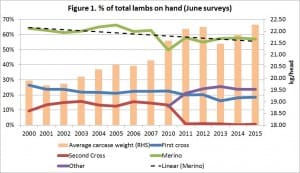 The June survey period was selected to allow a longer term comparison of Merino lamb numbers, as the survey was conducted annually in June until 2008, when it became tri-annual.
The June survey period was selected to allow a longer term comparison of Merino lamb numbers, as the survey was conducted annually in June until 2008, when it became tri-annual.
The survey format and breed codes changed in 2010, and data collection began on ‘other’ breed types such as terminal, composite and second cross breeds. The surveys indicate the growth in ‘other’ has been primarily driven by growing numbers in New South Wales and Victoria, while the proportions of the national total in Western Australia and South Australia have declined slightly.
Average lamb carcase weight increased about 1pc annually
The average carcase weight per animal has also been steadily rising since the 1980s, largely due to the increasing introduction of meat breeds, along with genetic advances and continually improving flock management. In 1980 the average Australian lamb carcase weight was 16.55kg, while the average in 2015 (January to September) is 22.28kg – as illustrated in Figure 1 (Australian Bureau of Statistics).
NSW’s share of Merino lamb crop lifts with falls in other states
The MLA and AWI wool and sheep meat June survey results indicate the number of Merino lambs on hand in NSW, as a proportion of the total Australian Merino lamb crop, have hovered around the 35pc mark over the past 13 years – consistently the highest percentage of all the states. As illustrated in Figure 2, NSW’s Merino lamb share dipped to 30pc in 2011, and has since recovered to 38pc – similar levels to 2001.
The proportion of Merino lambs in WA peaked at 32pc in 2007 and was followed by a steady decline to 25pc – where it has stabilised since 2013.
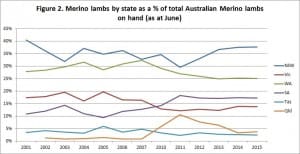 In SA, the percentage of Merino lambs in the Australian total has grown from 9pc in 2005, to peak at 18pc in 2011, and then steadied at 17pc. Victoria’s Merino lamb crop at June 2003 and 2005 accounted for 20pc of the Australian Merino lamb total, but the proportion dropped to 12-14pc in the past few years. Tasmania’s Merino lamb turnoff as a percentage of the national total has declined from around 6pc in 2005 to less 3pc in 2015.
In SA, the percentage of Merino lambs in the Australian total has grown from 9pc in 2005, to peak at 18pc in 2011, and then steadied at 17pc. Victoria’s Merino lamb crop at June 2003 and 2005 accounted for 20pc of the Australian Merino lamb total, but the proportion dropped to 12-14pc in the past few years. Tasmania’s Merino lamb turnoff as a percentage of the national total has declined from around 6pc in 2005 to less 3pc in 2015.
Merino lambs still make up about half of annual drop
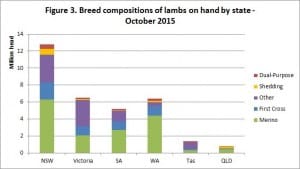 The latest MLA and AWI wool and sheep meat survey results, from October 2015, indicate that pure-bred Merino lambs accounted for 49pc of the national total lambs on hand, ‘other’ breed lambs made up 27pc, first cross lambs amounted to 16pc, while shedding and dual-purpose lambs each accounted for 4pc. The breed structure of lambs on hand in October 2015 on a state-by-state basis is illustrated in Figure 3.
The latest MLA and AWI wool and sheep meat survey results, from October 2015, indicate that pure-bred Merino lambs accounted for 49pc of the national total lambs on hand, ‘other’ breed lambs made up 27pc, first cross lambs amounted to 16pc, while shedding and dual-purpose lambs each accounted for 4pc. The breed structure of lambs on hand in October 2015 on a state-by-state basis is illustrated in Figure 3.
Further results from the MLA and AWI wool and sheep meat survey will be released on Tuesday 8th December in conjunction with MLA’s 2016 Sheep Industry Projections.
Source: Meat & Livestock Australia

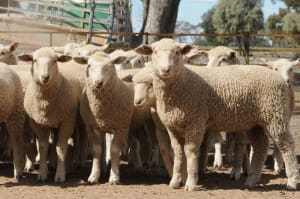
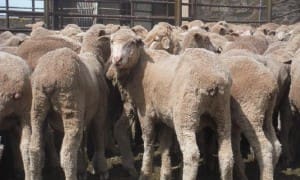
HAVE YOUR SAY